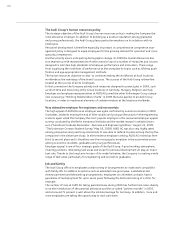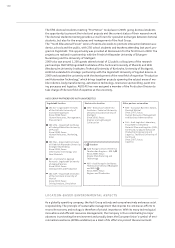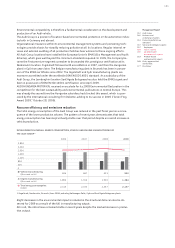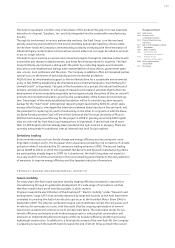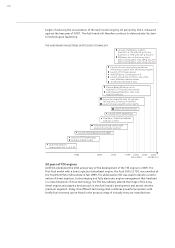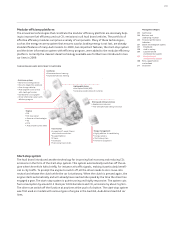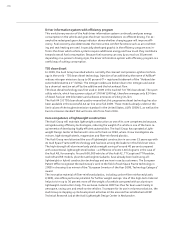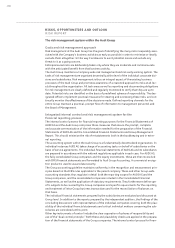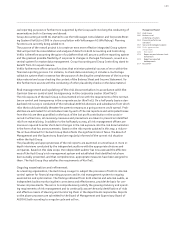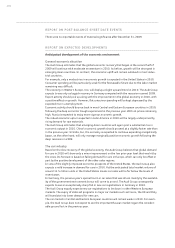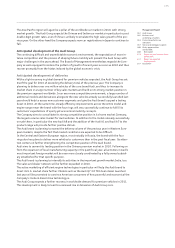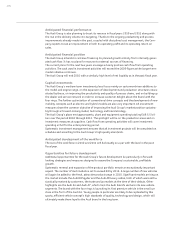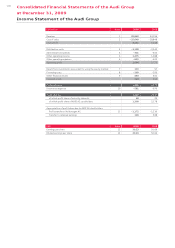Audi 2009 Annual Report Download - page 171
Download and view the complete annual report
Please find page 171 of the 2009 Audi annual report below. You can navigate through the pages in the report by either clicking on the pages listed below, or by using the keyword search tool below to find specific information within the annual report.
168
RISKS, OPPORTUNITIES AND OUTLOOK
RISK REPORT
The risk management system within the Audi Group
Goals and risk management approach
Risk management at the Audi Group has the goal of identifying the many risks inseparably asso-
ciated with the Company’s business activities as early as possible in order to minimize or ideally
exclude them altogether. In this way it endeavors to avert potential losses and exclude any
threat to it as a going concern.
Entrepreneurial risks are deliberately taken only where they are moderate and commensurate
with the anticipated benefit from that business activity.
The Audi Group maintains a Company-wide risk management and risk early warning system. The
tasks of risk management are organized decentrally at the level of the individual corporate divi-
sions and subsidiaries. Risk management is thus an integral aspect of the existing business
processes of the Audi Group and promotes awareness of a reasoned approach to risks at all lev-
els throughout the organization. All task areas as well as reporting and documenting obligations
for risk management are clearly defined and regularly monitored to verify that they are up to
date. Potential risks are identified on the basis of predefined spheres of responsibility. The des-
ignated officers implement practical measures for steering and overseeing these risks, and con-
tinually monitor the effectiveness of the decisions made. Defined reporting channels for the
entire Group maintain a practical, prompt flow of information to management personnel and
the Board of Management.
Integrated internal control and risk management system for the
financial reporting process
The internal control process for financial reporting purposes for the Financial Statements of
AUDI AG and the Audi Group comprises those measures that ensure the prompt, complete
and accurate communication of the information needed for the preparation of the Financial
Statements of AUDI AG and the Consolidated Financial Statements and Group Management
Report. This should minimize the risk of misstatements both in the bookkeeping and in exter-
nal reporting.
The accounting system within the Audi Group is a fundamentally decentralized organization. In
individual instances AUDI AG takes charge of accounting tasks on behalf of subsidiaries on the
basis of service agreements. The individual financial statements of AUDI AG and its subsidiaries
are prepared in accordance with the national regulations applicable in each case. For AUDI AG,
the fully consolidated Group companies and the equity investments, these are then reconciled
with IFRS financial statements and forwarded to Audi Group Accounting. A commercial encryp-
tion product is used to assure data security.
The Group accounting guideline maintains uniformity in the recognition and measurement prin-
ciples based on the IFRS rules applicable to the parent company. These and other Group-wide
accounting standards thus regulate in detail both the reporting scopes for AUDI AG and the
Group companies, and the consolidated companies included in the Consolidated Financial
Statements, as well as the application of statutory requirements. They furthermore define spe-
cific subjects to be covered by the Group companies and specific requirements for the reporting
and treatment of intra-Group business transactions and for the reconciliation of balances on
that basis.
The individual financial statements prepared by the subsidiaries are evaluated and discussed at
Group level. In addition to the reports prepared by the independent auditors, the findings of the
concluding discussions with representatives of the individual companies covering both the plau-
sibility of the individual financial statements and critical individual matters concerning the sub-
sidiaries are considered at this point.
Other key instruments of control include the clear separation of spheres of responsibility and
use of the “dual control principle.” Both these and plausibility checks are applied in the prepara-
tion of the financial statements of the Group companies. The internal control process for finan-


